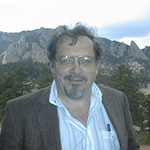Introduction
Some present research activities are summarized below. The research interest that underlies my research is the physics of the upper ocean and feedbacks with the atmosphere. Of particular interest are low frequency, large scale phenomena, and the role of the upper ocean as a conduit between the interior ocean and the atmosphere. Therefore, upper ocean models for global climate modeling studies are a particular focus. I am involved in small scale experiments, both observational and numerical (LES), that are designed to determine important upper ocean processes, and the signatures of these processes, so that their large scale significance can be assessed and modeled. The atmosphere-ocean forcing functions are a very important aspect of the problem, and I continue to try to improve our knowledge of them.
Ocean and Sea-Ice Modeling for Coupled Climate Models
Major products are state of the art ocean and sea-ice model components for the NCAR Community Climate System Model (CCSM). These components are being tested extensively and exercised in studies of the global ocean and of the impacts of sea-ice and atmospheric boundary conditions. There is currently a concerted effort to force a coupled ocean, sea-ice system in as similar a manner as practical to when coupled to an atmospheric model. Growing activities are the assessment of component performance within a coupled CCSM integration, as well as analysis of the coupled model output. Objectives are to investigate the interaction of the atmosphere and ocean in decadal climate fluctuations and to identify possible sources of climate drift in coupled models.
Forcing Numerical Models
The goal here is to specify the frequency and wavenumber content of forcing functions required to force numerical ocean models. One task is to quantify the ocean model response to high wavenumber (25-500 km) winds. Since important responses have been found, a means of obtaining the needed high wavenumber information at the required frequency from satellite scatterometer measurements was developed. The product is an annual cycle (August 1996 through July 1997) of global scatterometer based winds. The resolution is one-half degree in both the zonal and meridional directions and every six hours in time.
Education
Ph.D. Physical Oceanography
University of British Columbia, 1979
B.A. Sc., Honours, Engineering Physics
University of British Columbia, 1972
Background
Senior Scientist
National Center for Atmospheric Research, Boulder CO, 1998-Present
Associate Professor
University of British Columbia, Vancouver Canada, 1988-1989
Scientist III
National Center for Atmospheric Research, Boulder CO, 1986-1998
Scientist II
National Center for Atmospheric Research, Boulder CO, 1983-1986
Scientist I
National Center for Atmospheric Research, Boulder CO, 1980-1983
Postdoctoral Fellow
Institute of Oceanographic Sciences, Wormley UK, 1979-1980
Awards
- NASA Group Achievement Award, 1998
- American Meteorological Society Editor's Award, 1994
- Captain Thomas Byrne Prize, 1980, U.B.C.
- Canadian Meteorological and Oceanographic Society, Graduate Student Prize for 1979
- Postdoctoral Research Fellowship, 1980
Community Service
- Associate Editor, Journal of Geophysical Research, 2000-Present
- Associate Editor, Journal of Physical Oceanography, 1988-Present
- Co-Chairman from September, 1997
- NSF's Ocean-Atmosphere-Ice Interaction (OAII) SHEBA Surface Heat Budget of the Arctic) Advisory Committee, 1997-Present
- International WOCE Science Steering Group (SSG), 1996-Present
- CSM Principal Investigator Group, 1995-Present

